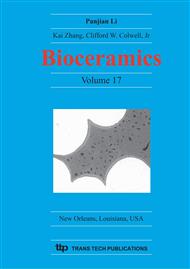p.643
p.647
p.651
p.655
p.659
p.663
p.667
p.671
p.675
The Study of the Frequency of Medium Changing in the Fabricating Tissue-Engineered Bone
Abstract:
Marrow mesenchymal cells contain stem cells and can regenerate tissue. We previously reported the clinical application of autologous cultured bone to regeneration therapy. However there is room for improvement in the culture methods; and here, we examined the optimal frequency of medium changing. Marrow cells were collected from the femur of a Fisher 7 week-old male rat. At 2 weeks after primary culture in a standard medium (MEM containing 15% bovine fetal serum), the cultures were trypsinized to prepare a cell suspension and divided into two groups, with or without addition of dexamethasone (Dex) to the osteogenic medium. To investigate optimal frequency, we further divided into 5 sub-groups; no changing (M0), 1 time/week (M1), 2/week (M2), 3/week (M3), and everyday (M7). After 2 weeks of subculture, the tissue was harvested and then ALP activity and calcium and DNA contents measured. In both of the Dex groups, there was significantly high ALP activity in the higher frequency group; but there was no significant DNA content. Also, in the Dex(+)group, there was a significant increase of calcium content in only the M3 and M7 sub-groups. Thus, we showed that the osteogenic potential of cultured bone is cultivated by increasing the frequency of medium changing.
Info:
Periodical:
Pages:
659-662
Citation:
Online since:
April 2005
Keywords:
Price:
Сopyright:
© 2005 Trans Tech Publications Ltd. All Rights Reserved
Share:
Citation:


